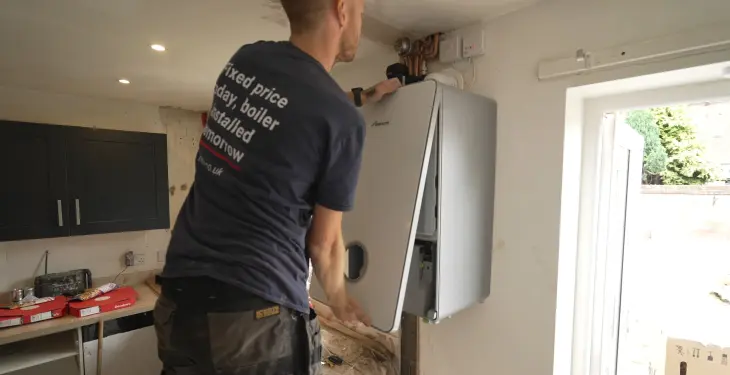

Written by Stephen Day
Gas Safe Engineer
Updated: 30th May, 2025
A Y Plan heating system is a design used in some homes to manage both central heating and hot water. It features a unique Y-shaped three-port valve that directs the flow of heated water.
Get a new boiler quote, save up to £550 per year (0% APR available).
The Y Plan wiring diagram is a crucial reference for those working with central heating systems. At its core, the Y Plan heating system expertly regulates both heating and hot water using a three-port motorised valve. This system has been a popular choice due to its efficiency and functionality, allowing users to control different heating zones within a home.
Understanding how the Y Plan system operates can significantly improve one's ability to troubleshoot common issues or maintain the system effectively. The wiring is designed to connect the boiler, programmer, room, and cylinder thermostats in a manner that optimizes the heating distribution. Additionally, knowing the advantages and potential pitfalls of the Y Plan can guide decisions on repairs or replacements.
Exploring the Y Plan also involves recognising when system components may need attention. Though generally reliable, there are times when the boiler or other parts might require replacement, and understanding the wiring diagram aids in making those assessments. Each element of the system must function cohesively to ensure maximum efficiency and comfort in the home.
Get a quote in 60 seconds, fitted as fast as next day!
0% APR finance available.
A Y Plan heating system is a design used in some homes to manage both central heating and hot water. It features a unique Y-shaped three-port valve that directs the flow of heated water.
This single valve efficiently controls whether heated water flows to the central heating system, the hot water cylinder, or both simultaneously.
One of the benefits of a Y Plan system is its simplicity. With only one motorised valve, it requires fewer components than some other systems, such as the S Plan. This can make installation quicker and possibly more cost-effective for smaller homes.
The system typically includes a programmer, thermostats for both the room and cylinder, and a boiler. These components work together to provide precise control over both central heating and hot water.
The programmer sets when the heating or hot water should operate. When heating is needed, the valve moves to allow water to flow to the central heating system. It shifts again to heat the hot water cylinder when hot water is required. If both are needed, the valve can position itself to serve both, demonstrating its versatility and efficiency.
This design helps in saving space while ensuring the house gets the right amount of heat and hot water, making the Y Plan a practical choice for many households.
A Y Plan heating system uses a single three-port valve to manage both hot water and central heating. This valve divides the flow, directing it either to the radiators or hot water cylinder, or both.
The system includes a room thermostat and a cylinder thermostat. The room thermostat regulates the room temperature. The cylinder thermostat controls the water temperature in the tank, ensuring efficiency and comfort.
Plumbing is essential to the system’s design. Pipes connect the boiler, radiators, and hot water cylinder. The three-port valve controls these pipes, functioning like a traffic director for water flow.
Key components of the Y Plan system include:
Three-port valve
Room thermostat
Cylinder thermostat
The wiring diagram is crucial. It shows how the electrical connections tie components together, ensuring proper communication and functionality. Each component relies on the diagram for installation and troubleshooting.
A programmer schedules when heating and hot water should be activated. This offers homeowners control over energy usage and cost.
Heatable components, like the thermostats, work to maintain desired temperatures. When the temperature drops, these thermostats signal the valve and boiler to heat more water, maintaining comfort in the home.
Advantages:
Fuel Efficiency: The Y Plan heating system generally offers lower fuel costs. Its efficient design can lead to significant savings, particularly in smaller homes.
Timed Operation: It includes a feature that allows timed operation of heating components, ensuring that the system runs only when needed.
Fewer Components: The Y Plan system requires fewer parts compared to some other systems, such as the S Plan. This can make installation simpler and less costly.
Precise Control: Homeowners have precise control over both hot water and heating. This ensures comfort throughout the home with a straightforward control mechanism.
Disadvantages:
Limitations for Larger Properties: While cost-effective for smaller homes, a Y Plan may not be ideal for larger properties with more complex needs.
Mid-Position Valve: The use of a mid-position valve can be a drawback if not properly maintained, as it directs the hot water flow, and any issues can disrupt heating.
Understanding these factors can help homeowners decide if a Y Plan is suitable for their heating needs, balancing the benefits with any potential challenges.
Y Plan heating systems often face issues with their valve motor. The motor can burn out or fail, leading to heating problems. The valve might not move to the correct position, causing either the heating or hot water to be unavailable.
Leaks in the 3 port valve are another common issue. These leaks can result from worn seals or corrosion. Leaking can lead to system inefficiencies or damage to other components.
Airlocks in the pipes can also occur, which might stop hot water from circulating properly. Bleeding the radiators can sometimes resolve this problem, allowing trapped air to escape.
Software glitches in the system's controller might lead to incorrect timing or temperature settings. Resetting or reprogramming the system's settings can be a simple fix in some cases.
Maintenance needs are essential. Regular check-ups ensure that the entire system functions correctly. Minor problems like loose connections or worn parts can be caught early and repaired to avoid major failures.
Finally, sediment build-up in the boiler or pipes can restrict water flow and reduce efficiency. Flushing the system might be needed to remove debris and improve performance. Including these tasks in regular maintenance can help prevent many of these problems.
It's important to know when a boiler or heating system needs replacement. Age is a key factor. Most systems last 10-15 years. After this time, efficiency drops, leading to higher energy bills.
Warning signs indicate it's time for a change. Frequent breakdowns are one example. Repair costs can quickly add up, making a new system a better investment.
Energy efficiency should be considered. Older models may struggle to meet current efficiency standards. Upgrading to an A-rated system can save on fuel costs, especially in detached homes.
Another reason for replacement is if the heating system becomes outdated. New technology often offers better control over heating. For example, some systems now have wireless controls for convenience.
Homeowners should weigh the costs versus benefits of a replacement. While a new system can be a significant expense, long-term savings from reduced energy use and fewer repairs can make it worthwhile.
A Y Plan heating system is a popular choice for central heating in many homes. It uses a 3 port valve to control the flow of hot water. This valve directs the water either to the heating system, the hot water cylinder, or both.
Key Components:
3 Port Valve: This is crucial for dividing water flow.
Wiring Centre: Connects all electrical components.
Boiler and Pump: Deliver heated water throughout the system.
A wiring diagram can help in understanding how these components are linked. The diagram shows the connections between the thermostat, programmer, and the 3 port valve.
Operation:
When only hot water is needed, the valve stays in position B.
For heating, the valve switches to position A.
If both are needed, the system supports this mode too.
Installing a Y Plan is often easier than an S Plan due to fewer components. This makes it a space-saving and cost-effective option. The straightforward layout of the wiring also aids in troubleshooting. Understanding the basics of this system ensures a well-functioning home heating system.
Get a quote in 60 seconds, fitted as fast as next day!
0% APR finance available.
Last updated: 30th May, 2025

Written by Stephen Day
Gas Safe Engineer at iHeat
Stephen Day is a Gas Safe registered and FGAS certified engineer with over 20 years of hands-on experience in the heating, cooling, and renewable energy industry, specialising in boiler installations, air conditioning, and heat pump systems.
LinkedInArticles by Stephen Day are reviewed by iHeat’s technical team to ensure accuracy and reliability.

22nd December, 2025
Based on data from over 7000 boiler installations completed by iHeat in the past 12 months...
 Read Article
Read Article

22nd December, 2025
Here’s a quick roundup of the best combi boilers for 2026.
 Read Article
Read Article

22nd December, 2025
When your old boiler breaks down and it comes time to replace it with a new one, it might...
 Read Article
Read Article
No obligation. Takes less than 60 seconds.